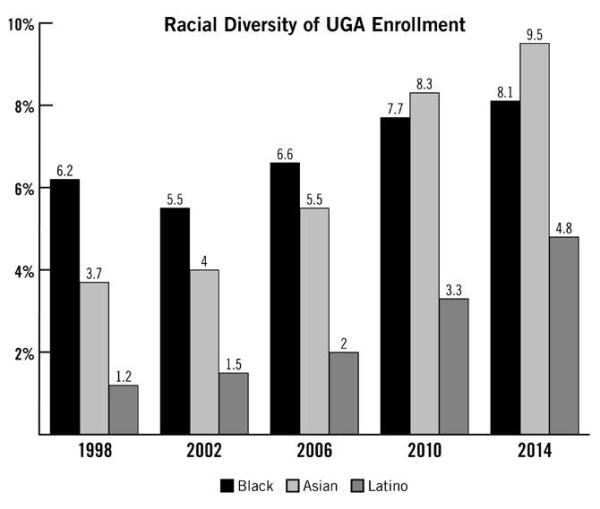Diverse Dawgs: Minority Enrollment Rises at UGA
The University of Georgia has made slow but steady strides to increase minority enrollment since Hamilton Holmes and Charlayne Hunter integrated the school in 1961, and UGA just welcomed its most diverse freshman class ever. However, diversity at UGA lags far behind the diversity of the state as a whole.
More than 1,700 of the 5,400 members of the class of 2020 identify as nonwhite, up 10 percent over last year, according to the university. “UGA has seen growth in the enrollment of underrepresented students over that time [I’ve worked here]. For example, 32 percent of first-year students in 2015 identified as something other than Caucasian,” says Patrick Winter, the associate vice president for admissions and enrollment for the past 10 years. “In 2005, only 20 percent of the first-year students identified as something other than Caucasian.”

Photo Credit: Larry Tenner
Mansur Buffins, president of the UGA chapter of the NAACP, attributes his decision to attend UGA to his experience at the Georgia African American Male Experience residential weekend program.
“During this program, members of the Black Male Leadership Society and faculty members from the Office of Institutional Diversity welcomed me, as well as other prospective black male students, with open arms and helpful intentions,” Buffins says. “I believe that this program is one of many major accomplishments of the University of Georgia in regards to increasing diversity and the culture of inclusivity on campus.”
Winter attributes UGA’s increase in diversity to a larger volume of applications from students across all ethnicities—23,000 this year, up 3 percent from 2015. This is no accident, as the university has made it a priority to recruit more diverse students with more outreach programs and need-based scholarships, although race isn’t used as a factor in admissions.
“UGA makes a deliberate effort to identify and recruit strong students from diverse backgrounds,” Winter says. “Admissions visits high schools, community agencies and college fairs across Georgia and the country to interact with potential students and their families. We host a number of on-campus events throughout the year to provide students the chance to visit and engage with the campus and get a sense of what the UGA experience would be like.”
Other programs that help recruit underrepresented students include Georgia Daze and Road Dawgs, Buffins says. Georgia Daze is a residential weekend program that allows high-school seniors who have been accepted into the university to come to campus and experience classes, meet with professors and learn about organizations on campus that serve underrepresented students. Road Dawgs involves UGA students taking a bus trip during spring break to different Georgia high schools, many of which are primarily comprised of students of color, and talking about UGA and answering students’ questions. The inaugural 2016 trip visited schools in Gwinnett, DeKalb, Fulton and Richmond counties.
The Road Dawgs initiative was created by a student and then embraced by the Office of Institutional Diversity. Buffins views this as a positive sign for UGA’s commitment to increasing diversity. Such programs are important because they let prospective students see that others like them are on campus, he says. “In order for underrepresented student enrollment to increase at the University of Georgia, it is important for these high-school students to see current UGA students who look like them.”
In a recent unscientific survey of UGA students, faculty and staff, only 62 percent of African Americans said they feel comfortable on campus—compared to 85 percent of whites—and 27 percent said they’ve been excluded, intimidated or experienced hostile conduct. Buffins, for one, believes the university is welcoming to students of color.
“I feel very comfortable at the University of Georgia. I think that, in general, the campus climate is very inclusive,” he says. “There is a place for anyone of any background on this campus, as well as an army of faculty members and administrators behind them ensuring that they feel safe and comfortable.”
The UGA student body is about 9 percent African American and 5 percent Latino. The state of Georgia, though, is 32 percent black and 9 percent Latino, according to the Census Bureau. That’s about in line with other Southern universities. For example, 7 percent of the Auburn University student body is black and 3 percent is Latino; Alabama is 27 percent black and 4 percent Latino. The University of South Carolina is 10 percent black and 4 percent Latino; the state is 28 percent black and 5 percent Latino.
Buffins does believe that the university has room for improvement, although he feels that UGA is moving in the right direction.
“I think the University of Georgia is doing a great job of addressing this need,” he says. “However, there is room for improvement, and I hope the university continues to do what it is doing, as well as expand present initiatives and support new initiatives in regards to increasing diversity and inclusion on campus.”













comments